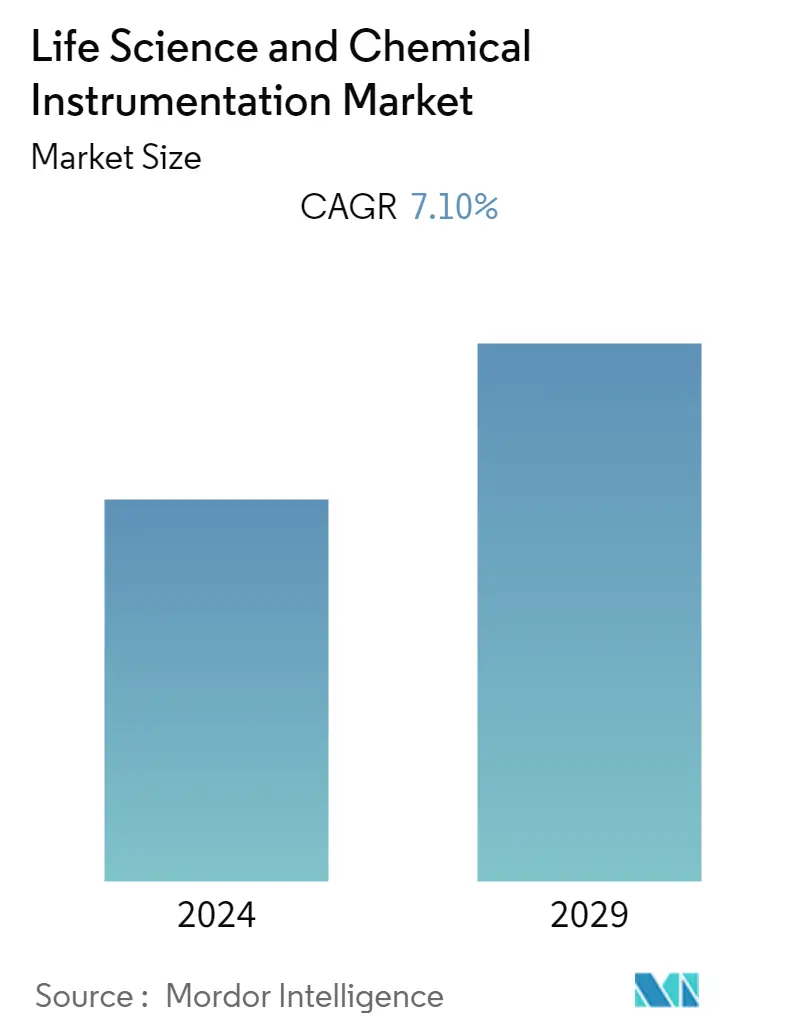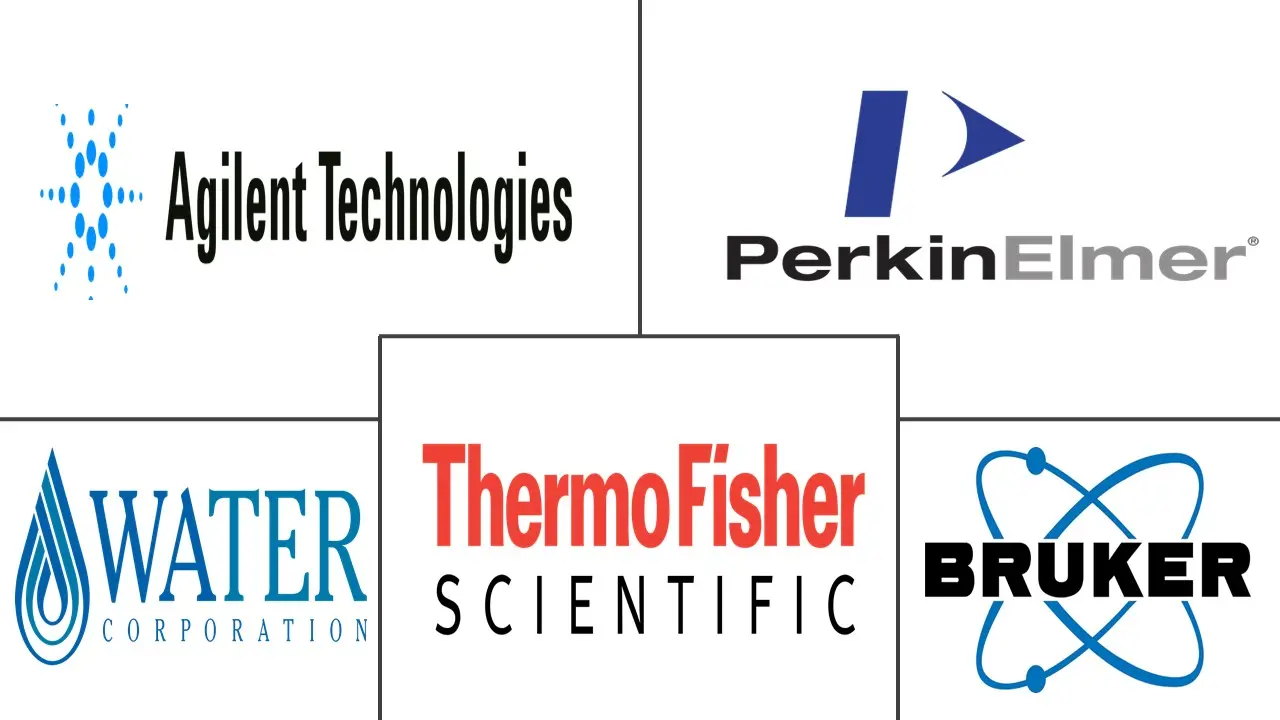Market Size of Life Science and Chemical Instrumentation Industry

| Study Period | 2021 - 2029 |
| Base Year For Estimation | 2023 |
| CAGR | 7.10 % |
| Fastest Growing Market | Asia-Pacific |
| Largest Market | North America |
| Market Concentration | Low |
Major Players
*Disclaimer: Major Players sorted in no particular order |
Life Science & Chemical Instrumentation Market Analysis
The Life Science and Chemical Instrumentation Market is expected to witness a CAGR of 7.1% during the forecast period.
The COVID-19 pandemic had a favorable impact on market growth globally, with the rapid development of diagnostics, expedited regulatory clearances, and increased distribution in many nations to help control the virus's spread. Several diagnostic procedures played a crucial role in detecting COVID-19. Diagnostic companies were continuously coming up with new launches in developing as well as developed countries. For instance, in July 2020, Roche introduced the Cobas 8800 instrument to the National Institute of Cholera and Enteric Diseases in India, and the Cobas 6800 at the National Institute for Research in Reproductive Health in India, to aid with SARS CoV-2 diagnostic testing. Roche's Cobas 6800/8800 systems produce test findings in three and a half hours and offer flexibility, greater operational efficiency, and the fastest time-to-time results. Thus, during the COVID-19 pandemic, the market for life science and the chemical instrument was positively impacted as the demand for these instruments increased during the pandemic. Currently, the market has reached its pre-pandemic nature in terms of demand for instruments and is expected to witness healthy growth in the coming years.
The life science and chemical instrumentation market is primarily driven by the growing R&D activities and the growing burden of diseases worldwide. In addition, the growing investment from the pharmaceutical industry in drug discovery and development is likely to boost the demand for life science instruments for drug validation.
The growing increasing public-private investments in life science research and technological advancements in analytical instruments are driving the market for life science instruments and chemicals. For instance, as per the article published by United Kingdom Parliament in October 2022, the total expenditure on R&D during 2022 was EUR 37.1 billion in the United Kingdom. Moreover, as per the OECD data, pharmaceutical spending as a percentage of GDP in 2021 was highest in Bulgaria, with around 32.4% spent on pharmaceuticals. Thus, growing pharmaceutical spending on research and development activity is expected to boost market growth over the forecast period.
Additionally, the high prevalence of infectious diseases and technological advancements in the field of life sciences and biotechnology support market growth. According to Statistics published by HIV.gov in June 2021, approximately 1.2 million people in the United States had HIV (Human Immunodeficiency Virus), with an incidence rate was 12.6 (per 100,000 population). This suggests that a high incidence of HIV will lead to increased demand for these instruments, thereby boosting market growth. Moreover, the launch of various instruments by the market players supports market growth. For instance, in June 2021, Thermo Fisher Scientific launched Invitrogen Attune CytPix Flow Cytometer, an imaging-enhanced flow cytometer that combines acoustic focusing flow cytometry technology with a high-speed camera.
Thus, all the above-mentioned factors are expected to boost market growth over the forecast period. However, the lack of skilled professionals and the high cost of life science and chemical instrumentation are further impeding the growth of the market.
Life Science & Chemical Instrumentation Industry Segmentation
As per the scope, instrumentation in life sciences and chemicals addresses different aspects of instrumentation that hold the keys to cutting-edge research and innovative applications. Various kinds of conventional instruments have been used in the life sciences and chemistry fields. Technology for the life sciences and chemistry has advanced tremendously in the past ten years in both the public and private sectors.
The Life Science and Chemical Instrumentation Market is Segmented by Technology (Polymerase Chain Reaction (PCR), DNA Sequencers and Amplifiers, Flow Cytometry, Spectroscopy, Electrophoresis, Chromatography, Centrifuges, and Other Technologies), End User (Hospitals and Diagnostic Centers, Pharmaceutical and Biotechnology Companies, Contract Research Organizations (CRO), and Academia and Research Institutes), and Geography (North America, Europe, Asia-Pacific, Middle-East and Africa, and South America). The market report also covers the estimated market sizes and trends for 17 different countries across major regions globally. The report offers the value (in USD million) for the above segments.
| By Technology | |
| Polymerase Chain Reaction (PCR) | |
| DNA Sequencers & Amplifiers | |
| Flow Cytometry | |
| Spectroscopy | |
| Electrophoresis | |
| Chromatography | |
| Centrifuges | |
| Other Technologies |
| By End Users | |
| Hospitals and Diagnostic Centers | |
| Pharmaceutical and Biotechnology Companies | |
| Contract Research Organization (CRO) | |
| Academia and Research Institutes |
| Geography | ||||||||
| ||||||||
| ||||||||
| ||||||||
| ||||||||
|
Life Science and Chemical Instrumentation Market Size Summary
The Life Science and Chemical Instrumentation Market is poised for significant growth, driven by increasing research and development activities and the rising global burden of diseases. The market experienced a positive impact during the COVID-19 pandemic due to the accelerated demand for diagnostic instruments, which has since stabilized to pre-pandemic levels. The pharmaceutical industry's investment in drug discovery and development is a key factor propelling the demand for life science instruments. Technological advancements in analytical instruments and increased public-private investments in life science research further bolster market expansion. Despite challenges such as the high cost of instrumentation and a shortage of skilled professionals, the market is expected to grow steadily over the forecast period.
Chromatography plays a crucial role in the market, particularly in pharmaceutical applications for drug validation and disease therapy monitoring. The introduction of advanced chromatography systems by key players like Waters Corporation and Shimadzu is expected to drive segment growth. In North America, the market benefits from the high prevalence of chronic diseases and the need for drug discovery, which fuels R&D activities. Product launches and strategic expansions by major companies, including Agilent Technologies and Thermo Fisher Scientific, are also contributing to market growth. Overall, the life science and chemical instrumentation market is set to experience robust growth, supported by technological innovations and increased funding for research initiatives.
Life Science and Chemical Instrumentation Market Size - Table of Contents
-
1. MARKET DYNAMICS
-
1.1 Market Overview
-
1.2 Market Drivers
-
1.2.1 Increasing Spending on Pharmaceutical R&D
-
1.2.2 Technological Advancements in Analytical Instruments
-
1.2.3 Increasing Public-Private Investments in Life Science Research
-
-
1.3 Market Restraints
-
1.3.1 High Cost of the Instruments
-
1.3.2 Lack of Skilled Professionals
-
-
1.4 Porter's Five Forces Analysis
-
1.4.1 Threat of New Entrants
-
1.4.2 Bargaining Power of Buyers/Consumers
-
1.4.3 Bargaining Power of Suppliers
-
1.4.4 Threat of Substitute Products
-
1.4.5 Intensity of Competitive Rivalry
-
-
-
2. MARKET SEGMENTATION (Market Size by Value - USD million)
-
2.1 By Technology
-
2.1.1 Polymerase Chain Reaction (PCR)
-
2.1.2 DNA Sequencers & Amplifiers
-
2.1.3 Flow Cytometry
-
2.1.4 Spectroscopy
-
2.1.5 Electrophoresis
-
2.1.6 Chromatography
-
2.1.7 Centrifuges
-
2.1.8 Other Technologies
-
-
2.2 By End Users
-
2.2.1 Hospitals and Diagnostic Centers
-
2.2.2 Pharmaceutical and Biotechnology Companies
-
2.2.3 Contract Research Organization (CRO)
-
2.2.4 Academia and Research Institutes
-
-
2.3 Geography
-
2.3.1 North America
-
2.3.1.1 United States
-
2.3.1.2 Canada
-
2.3.1.3 Mexico
-
-
2.3.2 Europe
-
2.3.2.1 Germany
-
2.3.2.2 United Kingdom
-
2.3.2.3 France
-
2.3.2.4 Italy
-
2.3.2.5 Spain
-
2.3.2.6 Rest of Europe
-
-
2.3.3 Asia-Pacific
-
2.3.3.1 China
-
2.3.3.2 Japan
-
2.3.3.3 India
-
2.3.3.4 Australia
-
2.3.3.5 South Korea
-
2.3.3.6 Rest of Asia-Pacific
-
-
2.3.4 Middle-East and Africa
-
2.3.4.1 GCC
-
2.3.4.2 South Africa
-
2.3.4.3 Rest of Middle-East and Africa
-
-
2.3.5 South America
-
2.3.5.1 Brazil
-
2.3.5.2 Argentina
-
2.3.5.3 Rest of South America
-
-
-
Life Science and Chemical Instrumentation Market Size FAQs
What is the current Life Science and Chemical Instrumentation Market size?
The Life Science and Chemical Instrumentation Market is projected to register a CAGR of 7.10% during the forecast period (2024-2029)
Who are the key players in Life Science and Chemical Instrumentation Market?
Agilent Technologies Inc., PerkinElmer, Inc, Bruker Corporation, Thermo Fisher Scientific Inc. and Water Corporation are the major companies operating in the Life Science and Chemical Instrumentation Market.

